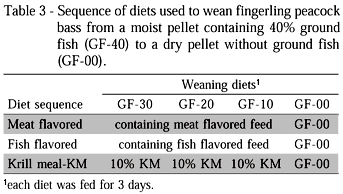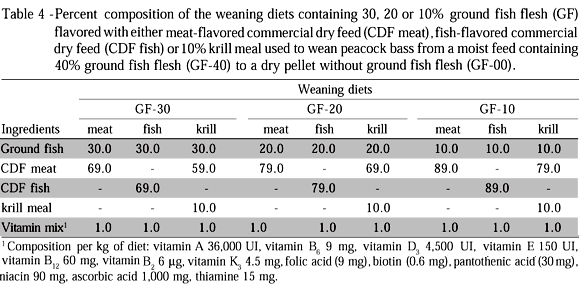The use of prized, carnivorous fish species such as the peacock bass Cichla sp. in either intensive farming or sport fishing demand specific knowledge on feed conditioning strategies for those species. One thousand and fifteen 0.5-g fingerlings were trained for 7 days to feed on ground fish flesh (GF). Seven hundred and seventy six (76%) fish (0.63 ± 0.03 g) feeding on GF were stocked into twelve 0.03-m³ net cages (63 fish/cage) and submitted to gradual feed ingredient transition (GFIT) weaning technique. Moist pellets with 90, 80, 70 or 60% GF (GF-90, GF-80, GF-70 or GF-60, respectively) were offered during the first 4 days of GFIT. No fish accepted GF-00 at the end of GFIT. Fish started on GF-90 or GF-80 fed well until GF dietary levels dropped below 40%. To improve acceptance of pellets containing 30% or less GF, a second trial with four 0.03-m³ net cages stocked with 120, 0.5-g fish feeding on GF was designed. Fish fed on a sequence of moist pellets containing 90, 80, 70, 60, 50 or 40% GF for 3 days. Approximately 81% of the fish accepted GF-40; they were pooled and restocked into nine 0.03-m³ net cages and weaned to GF-00 with a sequence of diets containing 30, 20 and 10% GF plus: 1) a meat-flavored dry, commercial feed (MEAT); 2) a fish-flavored dry, commercial feed (FISH); or 3) MEAT plus 10% krill meal (KM). Fish accepted fish-flavored pellets better than meat-flavored pellets. Addition of 10% krill meal to a meat-flavored feed improved pellet acceptance, even when ground fish flesh comprised only 10% of the feed. However, no fish accepted GF-00 pellets at the end of this study.
culture methods; carnivorous fish; weaning diets; pelleted diets






